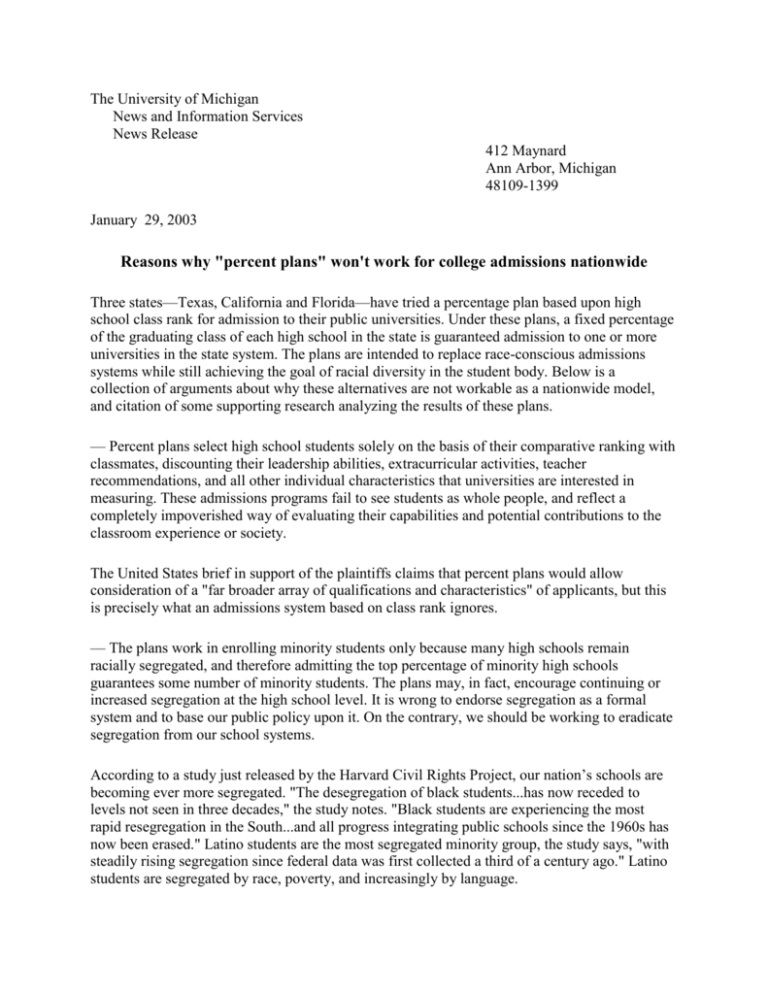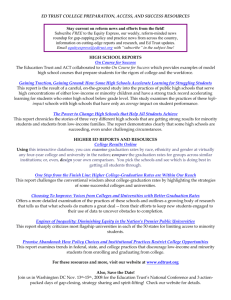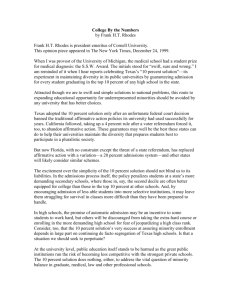"percent plans" won`t work for college admissions nationwide
advertisement

The University of Michigan News and Information Services News Release 412 Maynard Ann Arbor, Michigan 48109-1399 January 29, 2003 Reasons why "percent plans" won't work for college admissions nationwide Three states—Texas, California and Florida—have tried a percentage plan based upon high school class rank for admission to their public universities. Under these plans, a fixed percentage of the graduating class of each high school in the state is guaranteed admission to one or more universities in the state system. The plans are intended to replace race-conscious admissions systems while still achieving the goal of racial diversity in the student body. Below is a collection of arguments about why these alternatives are not workable as a nationwide model, and citation of some supporting research analyzing the results of these plans. — Percent plans select high school students solely on the basis of their comparative ranking with classmates, discounting their leadership abilities, extracurricular activities, teacher recommendations, and all other individual characteristics that universities are interested in measuring. These admissions programs fail to see students as whole people, and reflect a completely impoverished way of evaluating their capabilities and potential contributions to the classroom experience or society. The United States brief in support of the plaintiffs claims that percent plans would allow consideration of a "far broader array of qualifications and characteristics" of applicants, but this is precisely what an admissions system based on class rank ignores. — The plans work in enrolling minority students only because many high schools remain racially segregated, and therefore admitting the top percentage of minority high schools guarantees some number of minority students. The plans may, in fact, encourage continuing or increased segregation at the high school level. It is wrong to endorse segregation as a formal system and to base our public policy upon it. On the contrary, we should be working to eradicate segregation from our school systems. According to a study just released by the Harvard Civil Rights Project, our nation’s schools are becoming ever more segregated. "The desegregation of black students...has now receded to levels not seen in three decades," the study notes. "Black students are experiencing the most rapid resegregation in the South...and all progress integrating public schools since the 1960s has now been erased." Latino students are the most segregated minority group, the study says, "with steadily rising segregation since federal data was first collected a third of a century ago." Latino students are segregated by race, poverty, and increasingly by language. Asians, the report notes, are "the most integrated and the most educationally successful group in American schools." White students are the most segregated group of all, and "interact with few nonwhite students except in the South and Southwest." — The demographics of each state are different, and the results of these plans in various states would be uneven at best. California, Texas and Florida have large minority populations, while other states do not. In Michigan, for example, most underrepresented high schools are in rural, largely white areas of the state. Native Americans are always a very small minority in school districts, and are left out entirely by this approach to diversity. Depending upon the demographics of various states, Hispanic American and African American students also may find themselves in this predicament in some regions of the country. — These plans cannot create diversity in graduate and professional programs such as law school and medical school. — These plans take away the judgment of educators as to whether individual students are academically qualified for the level of work required at each college. Students in the top 10 percent of failing schools may be unprepared for college-level work and may require remedial support. For example, the University of Chicago has found that valedictorians from many disadvantaged schools in Chicago cannot succeed during the first year at the university because they are unprepared for the rigors of the academic program there. A Chronicle of Higher Education analysis of Florida data from 1997-98 showed that students at 75 of Florida's high schools could have carried a C+ average and still have ranked in the top fifth of their class. In the United States brief filed with the Supreme Court in the Grutter case (p. 17), the Justice Department argues that "public universities can address the desire for broad representation directly by...easing admissions requirements for all students." — Plans that rely solely on class rank encourage students to avoid hard classes and more competitive schools at the high school level, in order to superficially improve their GPA and class rank. University of Michigan pays close attention to the quality of the student's high school and the challenging nature of the student's high school curriculum. These criteria would be eliminated under a percentage plan. — Percent plans based on high school rank are unfair to high-achieving students attending competitive high schools. Students who are extremely well prepared to take advantage of the opportunities at the most selective colleges and universities may be excluded from admission under these systems. Consider this example from Florida cited by the Chronicle of Higher Education in a June 2, 2000, article: Mike Joseph and Leah Burton are two black seniors from Miami high schools. Joseph has a 4.0 GPA but takes less rigorous courses, and has a 1000 out of 1600 on the SAT. He ranks fourth in a class of 370 at one of the weakest schools in the city. Burton attends a competitive high school, where she ranks 213 out of 364. She is studying for three Advanced Placement exams, has a 3.9 GPA in a high-level curriculum, and an 1150 on the SAT. Under Florida's "Talented 20" program, Joseph would be admitted to the state's public university system and Burton would not. According to the Jan. 24, 2003, Detroit News, some students at Texas's competitive Westlake High School "have transferred to a less-competitive school so they will rise to the top of their new class." — The plans only work for universities that admit primarily from a statewide population. Public and private colleges and universities that recruit students from a national and international pool cannot apply this model to select their student bodies. At Michigan, for example, one-third of the student body comes from outside the state, and most of the Latino students who enroll are not Michigan residents. Over half of the applicants for Michigan's freshman class are from out of state, while only 11% of applicants to the University of Texas at Austin are nonresidents. — The plans rely to some extent on a statewide university system, so that if students are not able to attend one university in the system they can enroll in another. The University of Michigan, like many other state schools and all private colleges, is not part of a system. There is nowhere else the U-M can guarantee admission if applicants exceed available spaces in its freshman class. Requiring states to adopt such plans, therefore, would force some states to alter radically the entire structure of their higher education systems. — In operation, the plans fail to improve minority representation at the most selective campuses such as University of California at Berkeley, UCLA, University of Texas at Austin, University of Florida and Florida State University. In Texas, for example, from 1996 (the year before affirmative action was outlawed) to 2001, a U.S. Civil Rights Commission study found that the number of black students applying to UT Austin increased 24%, but the proportion of black applicants admitted decreased by 19%. The number of applications from Hispanic students increased by 20% but the proportion of those admitted declined by 15%. Despite the percent plans, minority enrollment at UT Austin is still lower today than prior to the Hopwood decision prohibiting the consideration of race, and both blacks and Hispanics continue to be underrepresented. Blacks made up only 3.4% and Hispanics 14.3% of the entering freshman class at UT Austin in Fall 2002. The population of Texas is 11.5% black and 32% Hispanic. A study of Texas college admissions published in January 2003 by faculty at Princeton, the University of Iowa and UT Austin found similar results. The authors write that "the top ten percent admission policy is not an alternative to affirmative action and by itself can achieve only minimal campus diversity, even in the presence of high levels of school segregation." In California, the Civil Rights Commission study found, proportionally fewer racial minorities apply or enroll in the state university system than in 1995, when the state banned consideration of race in admissions. In particular, the chances of admissions dropped for minority students at the Los Angeles, Berkeley and San Diego campuses. — Percent plans do not address the issue of financial aid targeted to minority students. According to the Jan. 17, 2003, Houston Chronicle, "while minority students with high grade point averages are guaranteed admission to [Texas] universities, they often can't afford to attend." The Houston paper noted that the Hopwood decision outlawed scholarships based on race along with race-conscious admissions. However, UT "now offers scholarships to specific schools that happen to be dominated by minority students." — Percent plans, if motivated by a desire to achieve racial diversity, may themselves be subject to constitutional scrutiny. Because they rely on residential and educational segregation patterns, they are not really "race-neutral." They are a less direct and less effective method of reaching the same goal. Indeed, these programs operate much more like set-asides or quotas than the U-M admissions programs. Many opponents of affirmative action challenge these programs as well. Said University of California Regent Ward Connerly in the June 2, 2000, Chronicle of Higher Education: "If you're picking a number because you know that number is going to favor one group or another based on race, that's no different than a system of explicit preferences. It's a lawsuit waiting to happen." The Chronicle article notes that aides to Gov. Jeb Bush of Florida said they settled on a 20percent standard after computer models of 10-percent and 15-percent policies failed to produce enough black and Hispanic students. The Center for Equal Opportunity, in its amicus brief in support of the plaintiffs in the Michigan cases, has asserted that such programs are unconstitutional because they are designed to ensure racial diversity. The adoption of such alternatives will not end litigation on these topics. This article can be found on the Web at http://www.umich.edu/~newsinfo/Releases/2003/Jan03/r012903.html More information about the two lawsuits against the University can be found on the Web at http://www.umich.edu/pres/bollinger/









